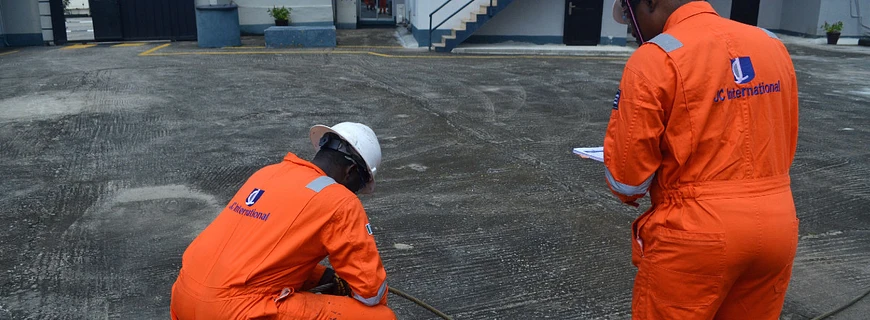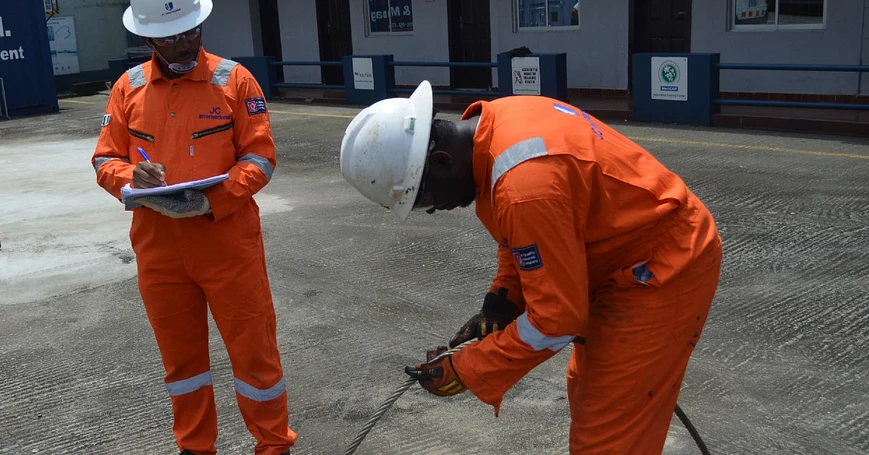OPTIMISING WIRE ROPE INSPECTION AND ASSESSMENT USING MRT TECHNOLOGY

Optimising Wire Rope Inspection and Assessment using MRT Technology
Wire ropes (especially running rope) are regarded as a safety critical expendable component, requiring immediate replacement when the results of inspection indicates wire rope defects – wear, deterioration, or damage beyond the point where safe and continued use can no longer be guaranteed.
Wire rope (for the purpose of his blog), refers to those ropes use for the following types of cranes:
- Cantilever cranes (pillar jib, wall, or walking).
- Deck cranes.
- Derrick and guy derrick cranes.
- Derrick cranes with rigid bracing.
- Floating cranes.
- Mobile cranes.
- Overhead traveling cranes
- Portal or semi-portal bridge cranes.
- Portal or semi-portal cranes.
- Railway cranes.
- Tower cranes.
- Offshore cranes, i.e. Cranes mounted on a fixed structure supported by the seabed or on a floating unit supported by buoyancy forces.
Every steel wire rope, which is subject to corrosion, abrasion, and fatigue, will fail suffer failure at some point if it is not detected, discarded, and replaced in time. For most duty holders, a periodic replacement of wire ropes is built into their safety management and maintenance strategy in addition to regular maintenance like lubrication and visual inspection.
Wire rope inspection using Magnetic Rope Tester (MRT) is driven by electro-magnetic principles and used as an aid to visual inspection to determine the location of sections of rope suffering deterioration. MRT technology has evolved rapidly over the years with advances in digitalization and innovative developments in design and manufacturing, now offers significant advantages as a non-destructive testing (NDT) technique.
Where it is intended to monitor the condition of a crane wire rope throughout its operational life then it is recommended that an NDT (MRT) be carried out on the rope at first installation in order to reveal any manufacturing defects and to establish baseline data against which the findings of further tests may be evaluated.
The challenges of wire rope operation often enable duty holders/operators to recognise the value of an MDT NDT inspection of ‘in-service’ crane ropes as a reliable means of inspection monitoring data collection.
Four major challenges in wire rope operation:
- Crane wire rope failure accidents caused by fatigue/strength loss are always prevalent in the use of steel wire ropes. According to survey conducted by Health and Safety Executive United Kingdom, 17% in-service wire ropes in 8,000 wire rope users are in “extremely dangerous” situation.
- Regular replacement of wire ropes causes huge waste in resources and manpower and therefore uneconomical. Majority of those wires replaced in line with maintenance routine have just little strength loss and generally in serviceable conditions.
- Traditional visual inspection method costs more time and labour, and therefore inefficient.
- Manual inspection is not reliable, and many hidden dangers cannot be detected.
In addition to the points above, failure to understand the scope, methods and standards of wire rope inspection, and acceptance /rejection criteria specified for all types of wire rope defects can lead to also failure and equipment unavailability.

Optimising MRT for Wire Rope Inspection:
As stated earlier, it is important to establish a baseline data for newly installed crane wire ropes. If it is the intention to carry out NDT by MRT means during the operational life of the rope, an initial examination should be carried out as soon as practicable. This could be during the following stages of the rope life cycle:
- Manufacture
- Installation
- First inspection after installation
The results of this inspection would serve as the baseline or reference point for future calibration.
NDT of crane wire ropes using MRT is a specialised operation often involving the use of equipment designed specifically for different types of rope. The next blog will look at some types of MRT machines currently in use in the industry, their benefits, and opportunities.
Other key features that must be considered when looking to optimise MRT as an NDT technique for wire rope inspection are detailed below:
- Different rope constructions are used for different applications in different types of cranes and some of these present more difficult NDT and visual examination problems than others. It is essential therefore to select appropriate NDT equipment.
- NDT can be carried out using alternating current (AC), direct current (DC) and permanent magnet type instruments. Data are presented in graphical form and will indicate the presence of broken wires, internal and external corrosion, and general wear in a rope. If a rope is severely corroded, the NDT instrument may not detect internal broken wires. This makes it essential to have a record of previous NDT reports for building a trend map.
- The MRT NDT is an aid to visual inspection, but it has the advantage of being able to detect internal or hidden defects. It is therefore useful as a routine periodic condition monitoring test providing data to allow for informed judgements on the condition of the rope. Although data can be obtained from a single test to ascertain the condition of the rope at the time of test, the main advantage of NDT using this method relies on the collection of data over time from routine periodic monitoring. Comparing data from routine periodic NDT allows any rope deterioration to be detected at an early stage, and the rate of deterioration can be assessed during its service life.
- It is also essential to recognise that running ropes are safety critical components and as such, testing and the reporting of tests should only be carried out by suitably trained and experienced personnel.
- In addition to the point above, the interpretation of the results also requires expert knowledge.
How can we help?
As members of the Associated Wire Rope Fabricators (AWRF), JC International offers the full suite of wire rope management services from NDT to visual wire rope inspection performed by experienced and qualified inspectors with sufficient skill and knowledge of acceptance and rejection criteria from relevant codes, standards, regulations and industry best practices.
Our investments in wire rope inspection technology allows us to focus on wire rope reliability and integrity throughout the operational and service life of the ropes. It also allows to continue to provide a world-class service, promoting safety performance by the most cost-effective means.

Leave a Reply